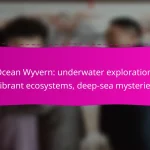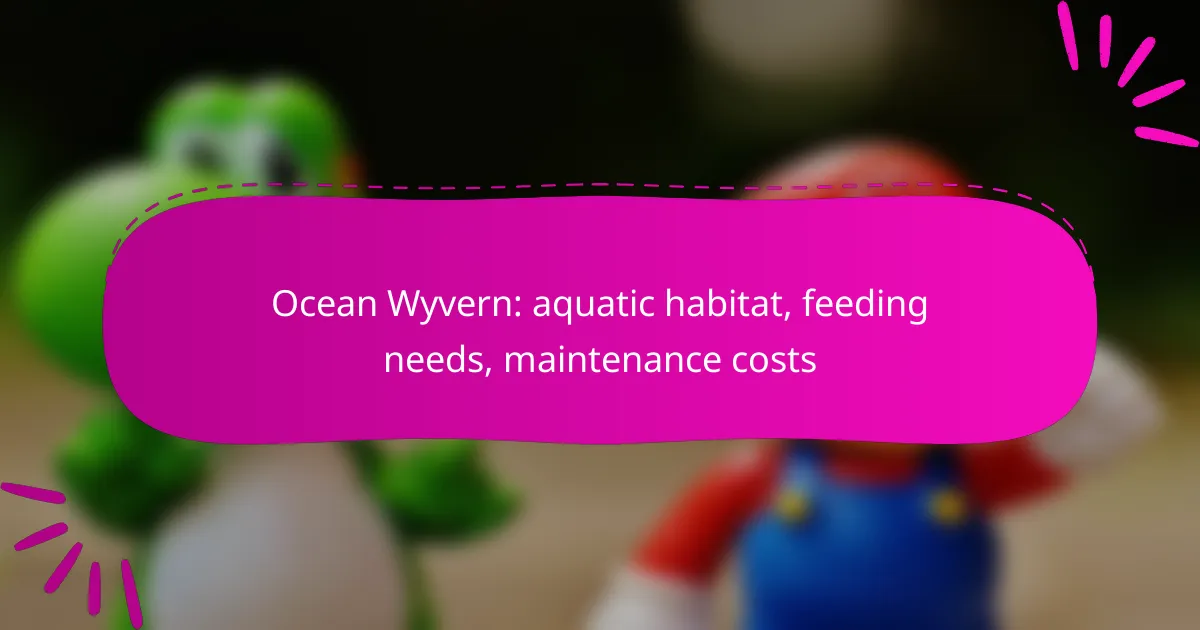Ocean Wyverns flourish in varied aquatic habitats like coral reefs and seagrass beds, which provide essential food and shelter. Their diet mainly consists of small fish and crustaceans, ensuring they receive the necessary nutrients for optimal health. However, maintaining these majestic creatures can be costly, with annual expenses ranging from a few hundred to several thousand dollars, depending on habitat size and care requirements.
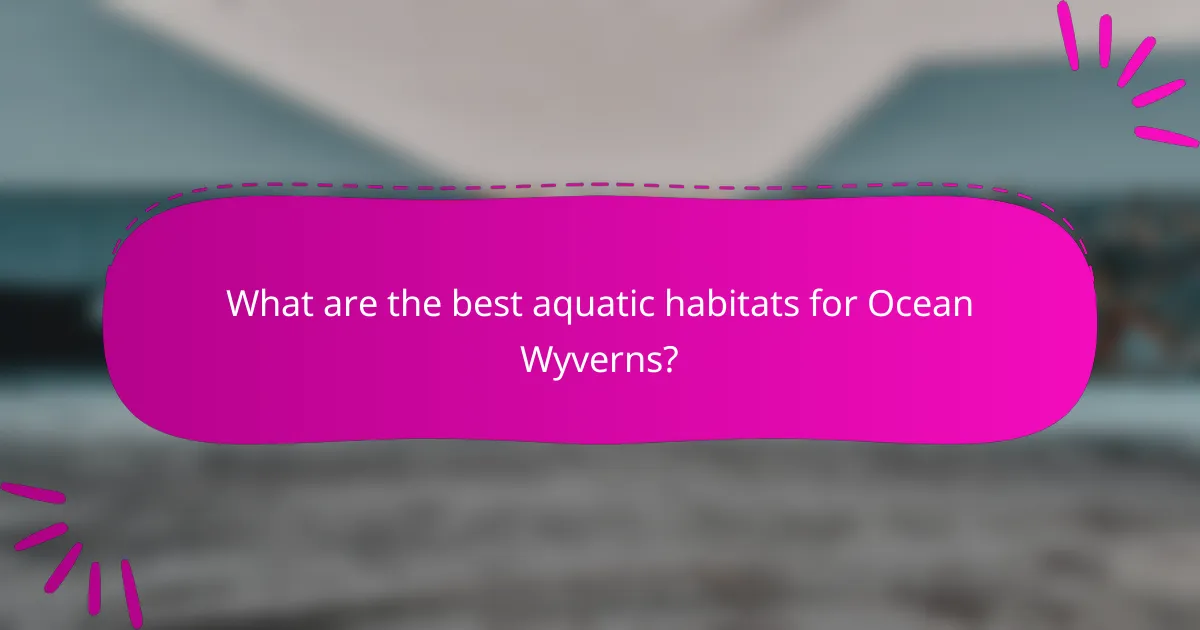
What are the best aquatic habitats for Ocean Wyverns?
Ocean Wyverns thrive in diverse aquatic habitats that provide ample food and shelter. The best environments include coral reefs, seagrass beds, and the open ocean, each offering unique benefits for their survival and well-being.
Coral reefs
Coral reefs are vibrant ecosystems that support a wide range of marine life, making them ideal habitats for Ocean Wyverns. These areas provide abundant food sources, such as small fish and crustaceans, which are essential for their diet.
When considering coral reefs, ensure that the water quality is high and that the temperature remains stable, typically between 24°C and 29°C. Regular monitoring of pH levels and nutrient concentrations can help maintain a healthy environment for these creatures.
Seagrass beds
Seagrass beds are another excellent habitat for Ocean Wyverns, offering shelter and a rich supply of food. These underwater meadows are home to various small marine organisms that serve as prey, making them a vital feeding ground.
To maintain a thriving seagrass habitat, it’s important to manage water clarity and minimize pollution. Regular assessments of seagrass health can help ensure that these areas remain productive and supportive of Ocean Wyverns.
Open ocean
The open ocean provides a vast and dynamic environment for Ocean Wyverns, where they can hunt for larger prey such as schools of fish. This habitat allows for greater mobility and access to diverse food sources.
However, the open ocean can be challenging due to its unpredictable conditions. It’s crucial to monitor weather patterns and currents, as well as to ensure that the Wyverns have adequate space to roam and hunt without excessive stress from environmental factors.
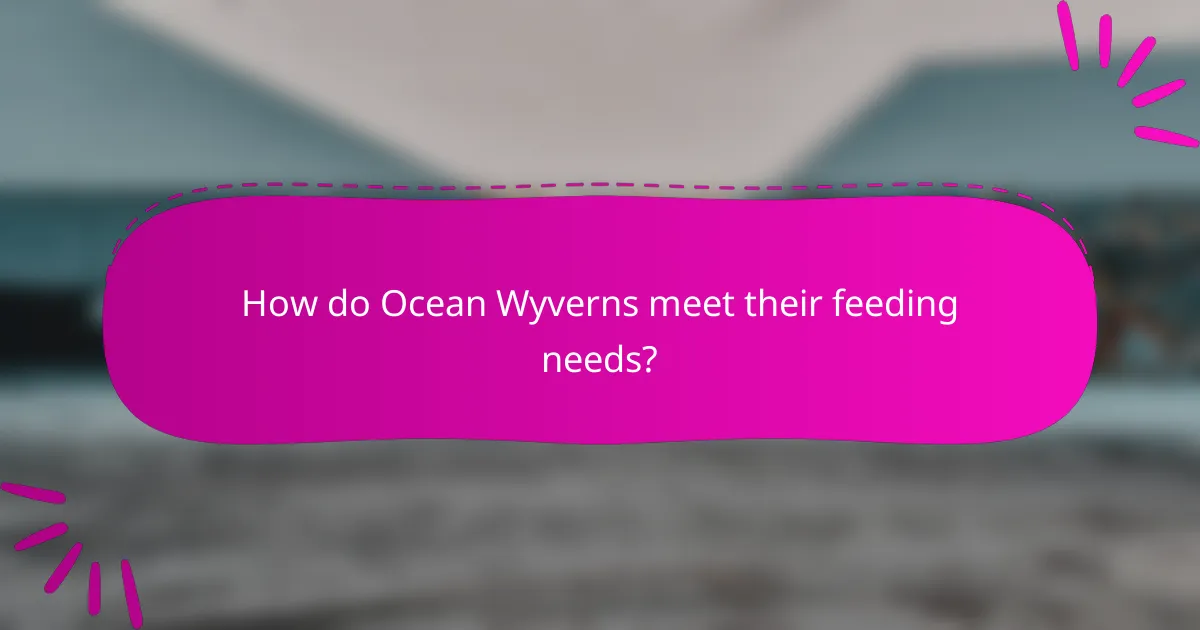
How do Ocean Wyverns meet their feeding needs?
Ocean Wyverns primarily meet their feeding needs by consuming small fish, which form the bulk of their diet. They also supplement their intake with crustaceans, ensuring a balanced nutritional profile that supports their health and energy levels.
Primary diet of small fish
The primary diet of Ocean Wyverns consists mainly of small fish species, such as sardines and anchovies. These fish are abundant in coastal waters, making them easily accessible for hunting. Wyverns typically hunt in schools, using their agility to catch multiple fish at once.
When feeding, Ocean Wyverns employ a technique of rapid dives and sharp turns to capture their prey. It’s essential to monitor the availability of these fish in their habitat to ensure a consistent food supply. A healthy population of small fish can significantly reduce the maintenance costs associated with feeding.
Supplemental feeding on crustaceans
In addition to small fish, Ocean Wyverns also consume crustaceans like shrimp and crabs as a supplemental food source. This variety in diet helps to meet their nutritional requirements, particularly for protein and essential fatty acids. Crustaceans are often found in the same habitats as small fish, making them a convenient option.
When providing supplemental feeding, it’s important to ensure that crustaceans are fresh and sourced from sustainable fisheries. This not only supports the health of the Wyverns but also aligns with environmental regulations regarding marine life. Regularly incorporating crustaceans into their diet can enhance their overall well-being and vitality.
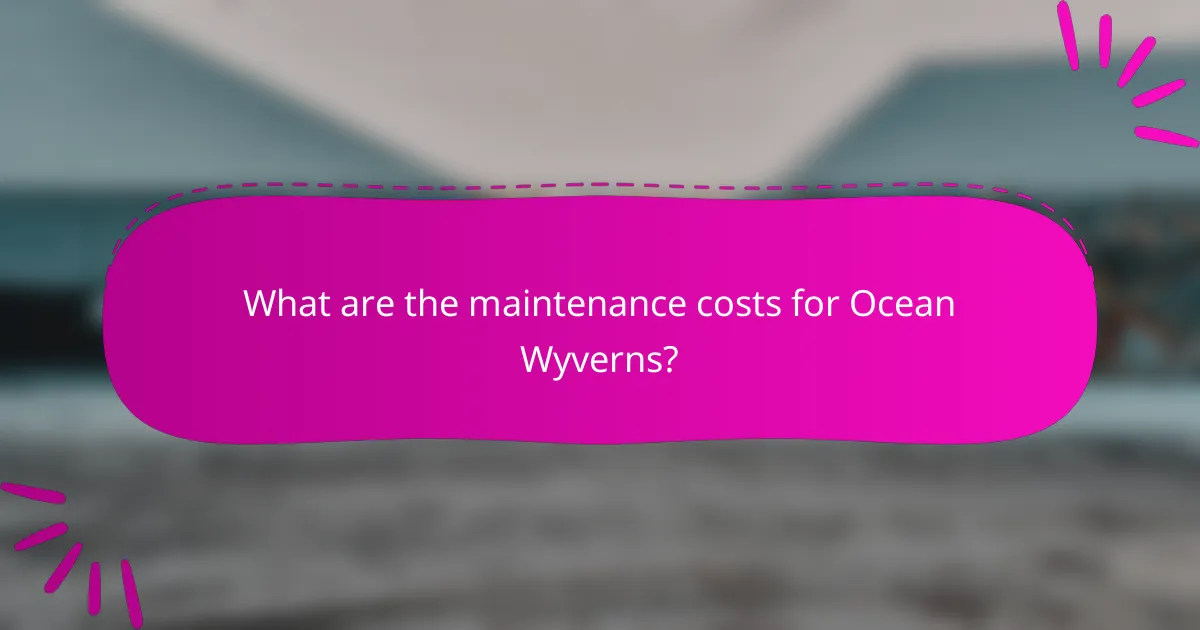
What are the maintenance costs for Ocean Wyverns?
The maintenance costs for Ocean Wyverns can vary significantly based on factors such as habitat size, feeding needs, and water quality management. On average, you can expect to spend a few hundred to several thousand dollars annually to ensure their well-being.
Initial setup costs
Setting up a suitable habitat for Ocean Wyverns involves substantial initial expenses. This includes constructing a large aquatic enclosure, which can range from a few thousand to tens of thousands of dollars depending on size and materials used. Additionally, you’ll need to invest in filtration systems, heating elements, and other equipment to maintain optimal living conditions.
Consider budgeting for decorative elements and enrichment items to create a stimulating environment. These can add several hundred dollars to your initial costs, but they are essential for the health and happiness of your Ocean Wyvern.
Ongoing food expenses
Feeding Ocean Wyverns can be a significant ongoing expense. Depending on their size and dietary needs, you may spend anywhere from $50 to several hundred dollars per month on high-quality aquatic feed. It’s crucial to provide a balanced diet that includes a variety of proteins and nutrients to support their growth and health.
Buying in bulk can help reduce costs, but ensure that the feed is fresh and suitable for their specific dietary requirements. Regularly monitor their feeding habits to adjust portions and avoid waste.
Water quality management
Maintaining water quality is essential for the health of Ocean Wyverns and can incur ongoing costs. Regular testing kits and treatments for pH, ammonia, and nitrate levels can cost between $20 and $100 monthly. Investing in a reliable filtration system is also crucial, with replacement filters adding to your expenses.
Establish a routine for water changes and maintenance to prevent costly health issues. Regularly monitoring water quality can help you catch problems early, potentially saving money on veterinary care and ensuring a healthy environment for your Ocean Wyvern.

What factors influence the habitat choice for Ocean Wyverns?
Ocean Wyverns thrive in specific aquatic environments influenced by water temperature and salinity levels. Understanding these factors is crucial for creating suitable habitats that meet their biological needs.
Water temperature
Water temperature is a critical factor for Ocean Wyverns, as it affects their metabolism and overall health. These creatures typically prefer temperatures ranging from 20°C to 28°C, which supports their active lifestyle and feeding habits.
When maintaining an aquarium or habitat for Ocean Wyverns, ensure that the water temperature remains stable within this range. Sudden fluctuations can lead to stress and health issues, so consider using heaters or chillers as necessary.
Salinity levels
Salinity levels are equally important for Ocean Wyverns, as they are adapted to specific salt concentrations in their environment. Ideal salinity for these creatures usually falls between 30 to 35 parts per thousand (ppt), mimicking the conditions found in natural marine habitats.
To maintain proper salinity, regularly test the water and adjust using marine salt mixes if needed. Avoid drastic changes in salinity, as this can adversely affect the health of Ocean Wyverns, leading to potential stress or mortality.

How can you ensure proper feeding for Ocean Wyverns?
To ensure proper feeding for Ocean Wyverns, establish a consistent feeding routine and provide a diet that meets their nutritional needs. This involves understanding their natural feeding habits and adjusting your approach based on their specific requirements.
Regular feeding schedule
Maintaining a regular feeding schedule is crucial for the health of Ocean Wyverns. Aim to feed them at the same times each day, ideally two to three times daily, to mimic their natural feeding patterns. Consistency helps regulate their metabolism and promotes overall well-being.
Monitor their feeding behavior closely. If they show signs of hunger or disinterest, adjust the timing or quantity of food accordingly. Avoid overfeeding, as this can lead to health issues.
Balanced diet formulation
A balanced diet for Ocean Wyverns should include a mix of proteins, fats, and essential vitamins and minerals. Consider incorporating high-quality fish, crustaceans, and specially formulated aquatic pellets to meet their dietary needs. Aim for a protein content of around 30-40% in their diet.
Additionally, supplement their diet with vitamins and minerals to ensure they receive all necessary nutrients. Regularly assess their health and adjust the diet as needed, consulting with a veterinarian experienced in aquatic species for tailored advice.
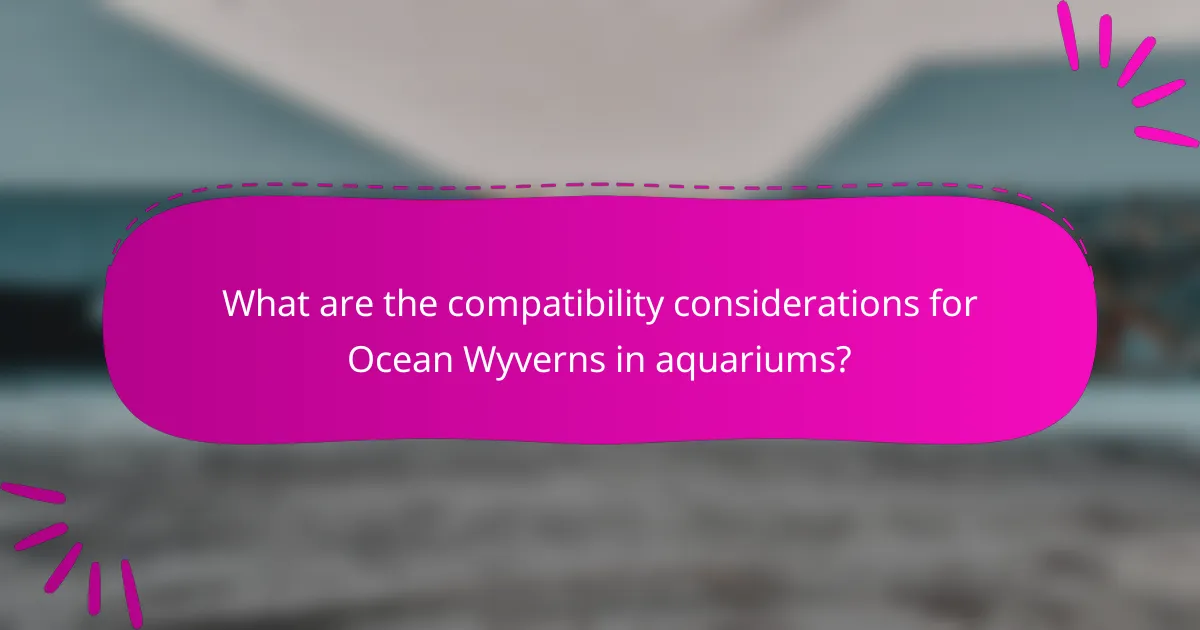
What are the compatibility considerations for Ocean Wyverns in aquariums?
When keeping Ocean Wyverns in aquariums, compatibility with other species and the right environmental conditions are crucial for their health and well-being. Ensuring suitable tank mates and maintaining appropriate habitat parameters will help create a thriving aquatic environment.
Tank mates
Choosing the right tank mates for Ocean Wyverns is essential to prevent aggression and stress. Ideal companions include larger, non-aggressive fish and invertebrates that can withstand similar water conditions. Avoid smaller or territorial species that may provoke the Wyverns or become prey.
Common compatible tank mates include species like large angelfish, certain types of wrasses, and peaceful triggerfish. Always monitor interactions closely, especially during the initial introduction phase, to ensure harmony within the tank.
Environmental conditions
Ocean Wyverns thrive in specific environmental conditions that mimic their natural habitat. They require a spacious tank with ample swimming room, ideally over 200 gallons, and a well-maintained filtration system to keep water quality high. Temperature should be maintained between 24-28°C (75-82°F) with stable salinity levels around 1.020-1.025 specific gravity.
Additionally, incorporating natural elements like rocks and plants can provide hiding spots and reduce stress. Regular water changes and monitoring of pH levels (ideally between 8.1-8.4) are crucial for maintaining a healthy environment for these creatures.
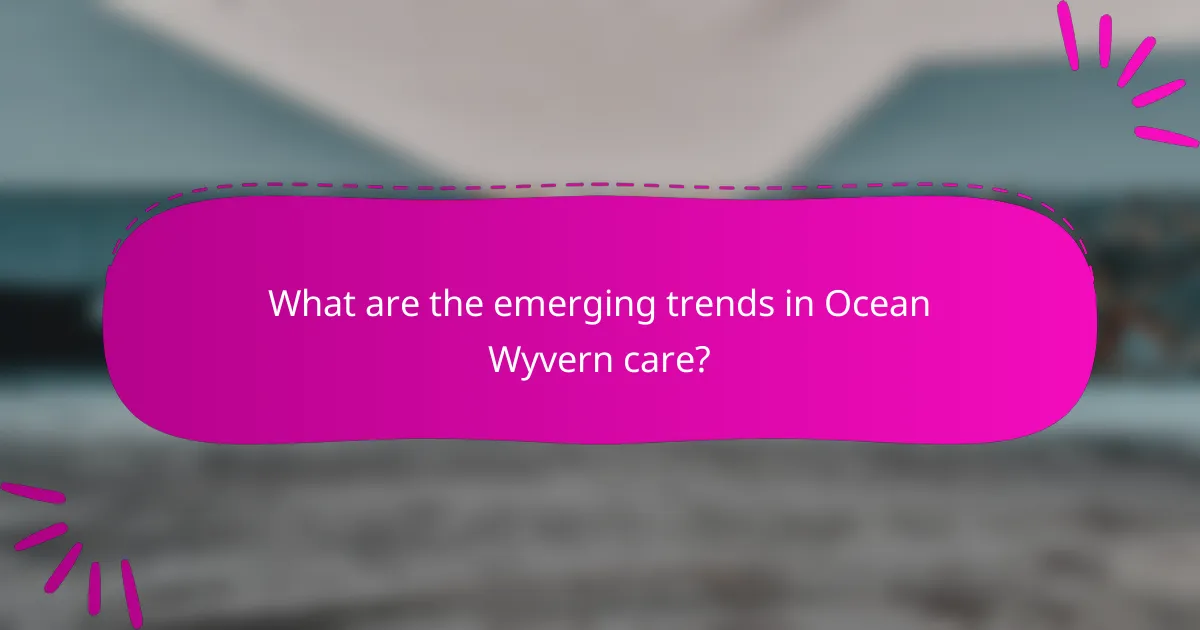
What are the emerging trends in Ocean Wyvern care?
Emerging trends in Ocean Wyvern care focus on enhancing their aquatic habitats, optimizing feeding practices, and managing maintenance costs effectively. As interest in these creatures grows, so does the need for sustainable and efficient care methods.
Aquatic habitat
Creating an optimal aquatic habitat for Ocean Wyverns is crucial for their health and well-being. These creatures thrive in environments that mimic their natural habitats, which typically include a mix of saltwater and freshwater. Consider incorporating live plants, rocks, and varied water depths to promote natural behaviors.
Regular monitoring of water quality is essential. Parameters such as pH, salinity, and temperature should be maintained within specific ranges to prevent stress and illness. Utilizing filtration systems and performing routine water changes can help maintain a stable environment.
Feeding needs
Ocean Wyverns have specific dietary requirements that must be met to ensure their health. They primarily consume a diet rich in protein, which can include fish, crustaceans, and specialized pellets designed for aquatic reptiles. Providing a varied diet helps prevent nutritional deficiencies.
Feeding frequency can vary based on age and activity level, but generally, adult Ocean Wyverns benefit from being fed every few days, while younger ones may require daily feedings. Observing their eating habits can help you adjust portions and types of food accordingly.
Maintenance costs
Maintenance costs for Ocean Wyverns can vary widely depending on habitat setup and feeding practices. Initial setup costs may include tanks, filtration systems, and decorations, which can range from a few hundred to several thousand dollars. Ongoing expenses include food, water treatments, and electricity for equipment.
To manage costs effectively, consider bulk purchasing of food and supplies, and regularly assess your habitat setup for efficiency. Keeping a detailed budget can help you anticipate and control expenses over time, ensuring that you provide the best care without overspending.





